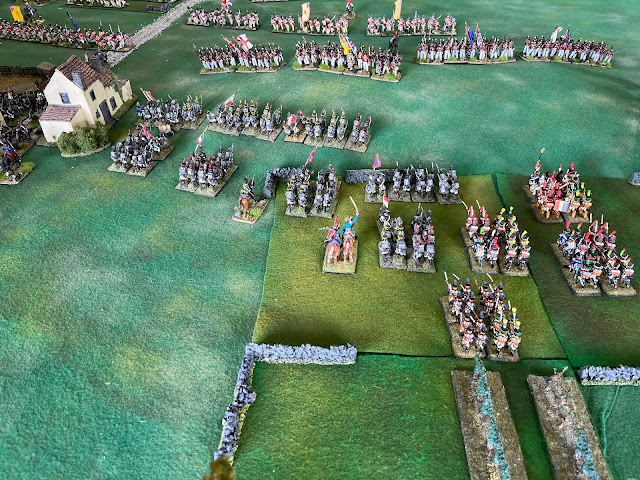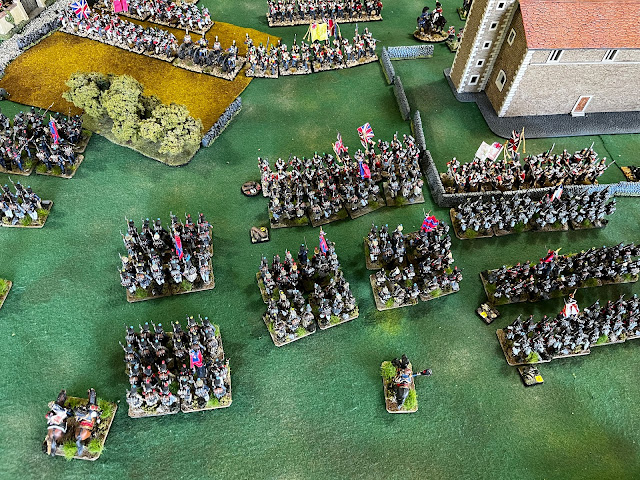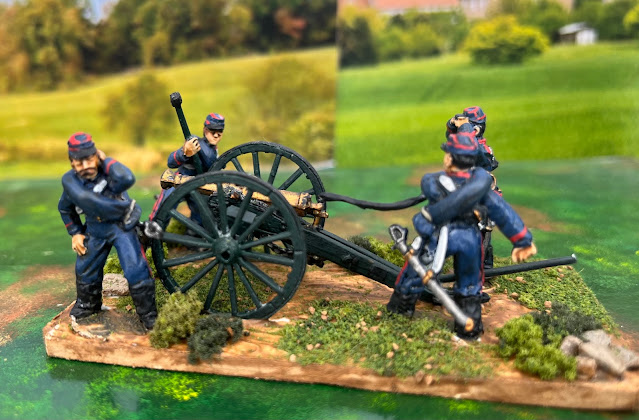Pages
Wednesday, 27 December 2023
A Few Days in the Tropics
Sunday, 24 December 2023
Over the Hills...A Couple of Christmas Eve Projects
For many years now I have made a habit of not leaving the property on Christmas Eve. It's just too crazy out there. It was bad enough doing the food shop yesterday - we went out as early as we could, but it was chaotically busy and as usual the price of the great New Zealand Christmas standards of strawberries, raspberries and cherries were through the roof. Thankfully we planted some raspberry canes a couple of years back and we will be feasting on homegrown raspberries and blueberries tomorrow. Most of my chores and tasks were sorted on Saturday and this had left me time to revisit some long neglected projects.
Towards the end of January 2022 I completed the larger part of my terrain tile project. Since then the last five frames have sat unassembled on my desk while I tried to figure out what feature to put into them. In the last few weeks I have thought that I need to have an area of coastline for naval landings. The five frames will be: an estuary linking to existing river sections, three straight beach sections and one end piece.
 |
The basic frame required a unique profile to go from ground level to sea level. |
 |
| Above are the first two tiles: the estuary on the left and a straight on the right. In this state they will have to remain for a while until the glue has set and some more time is available. |
Also on the work plan is a series of hills that will sit on top of the tiles. I decided on this because creating tiles with hills on them would create too great an inventory and at any rate placing the hill on top of the surface had the added advantage of concealing the joint between the tiles, helping to remove the checkerboard appearance. I had made a sample hill a couple of years ago (below) and that convinced me that this was the way to go.
I had purchased a piece of 4.75mm MDF for the hill bases some time ago and it has been sitting idle ever since, so I marked up an array of sizes and shapes - with one 600mm ridge, a couple 450mm long some at 300mm and some at 200mm. One or two of them are destined to become steep hills.
The pieces were then cut from the sheet with the jigsaw.
Saturday, 23 December 2023
Temporary Halt to the FPW Project
With the completion of the last few infantry figures the FPW project has come to a halt because I have now completed everything in this project except for items not yet released.
 |
| With the project on hold and no more red pants to paint, an engineer turns off the red paint pipeline. |
The last few French painted were some skirmish stands and seven spare officer figures (some of which will be used for artillery commanders). Most of the officers have had additions from other ranges - the revolver hand comes from one of the ACW sets and the binoculars come from the Warlord WWII German Blitzkrieg set...it is so nice to have a big box of bits and bobs left over from various plastics sets.
In recapitulation the completed FPW components are:
Prussians
- 2 x mounted generals
- 2 regiments of cuirassiers
- 2 regiments of uhlans
- 2 regiments of dragoons
- 5 regiments of hussars
- 1 battalion of Jägers
- 24 battalions of line infantry
- 18 skirmish bases
- 6 light field batteries
- 6 heavy field batteries
- 4 horse batteries
French
- 4 mounted generals
- 11 foot generals/colonels
- 2 regiments chasseurs à Cheval
- 3 battalions chasseurs à pied
- 36 line infantry battalions
- 18 skirmish stands
- 8 light field artillery batteries
- 4 light horse artillery batteries
- 3 mitrailleuse batteries
- 2 heavy field batteries
Thursday, 21 December 2023
The Last of the French Reserve Artillery
So the French artillery is finished. With these two batteries, Captain Petelle's 10/5e batterie de 4 and Captain Calemard du Genestoux's 6/15e batterie de 4 the 2nd Corpe reserve artillery is completed.
 |
| All six batteries of the reserve, the light field batteries on the left, the horse batteries in the centre and the heavies on the right |
 |
| The reserve on the left then to the right the guns of the 1st, 2nd and 3rd Divisions |
Tuesday, 19 December 2023
French Horse Artillery
Today sees the completion of the horse artillery division of the 2nd Corps artillery reserve. This consisted of two batteries equipped with canon 4 la Hitte guns: Captain Saget's 7/17e battery and Captain d'Esclaibes' 8/17e battery.
There was a little bit of conversion work required on these. First, they were given false boots rather than the line artillery gaiters. Second, the all received sabres courtesy of left overs from various plastic sets. They should not, of course, be wearing the greatcoat rolled across the shoulder (these would normally be left with the horses), but removing those would not be in any way practical, and I can live with this.
Next up will be the two light field batteries from the reserve, and that will mark the last of the artillery for this collection.
Monday, 18 December 2023
Napoleonic Peninsular Game
Yesterday I ran a Napoleonic game based on Corunna - well the armies and the strategic situation was historically based, but the terrain and the inclusion of a Spanish force was not historical.
Background
In the winter of 1808-09 the British army is in retreat across northern Spain doggedly pursued by the French. A series of sharp rearguard actions that, combined with the harsh winter conditions, was hard on the troops. On 12 January the British arrived at the port of Corunna on the northern coast of Spain from where the Royal Navy was expected evacuate them, but the transport ships have not arrived.
The French were slow to arrive, but on the morning of the 14th they were present in force. Late that same day the first of the transports have arrived and the loading of transport, much of the artillery and some cavalry occurred that night, but much more time will be required for the whole army. The British will need to stand and fight and must hold a position until nightfall on the 15th (that is 3:30 PM on game day), when evacuation proper would begin. A stout defence was a necessity.
The Forces
The British have 22 battalions in eight brigades, five light cavalry regiments in two brigades and two small field artillery batteries. In support is a Spanish force of eleven infantry battalions, two regiments of heavy cavalry and a field battery.
The French have eight regiments of dragoons, and four of light cavalry in six brigades, 39 battalions in eight brigades and three field batteries.
Deployment
The British will deploy first at any point north of the centre line, including inside the monastery grounds (with a maximum of two battalions therein), but short of Portargo. They may deploy on the reverse slope of the long ridge (the crest will run down the centre of the ridge). Troops behind terrain do not have to be deployed until the enemy has deployed. They can hold as many units off table as they wish (the Spanish must be off table until called), but all off table units must be marked on the map where they wish them to come on. To call up off table troops in their marked position will require a die roll of 3+ first attempt, but automatically on the second attempt. If you wish to bring them on in a different location to that marked, a 5+ is required first attempt, a 3+ second attempt and they will arrive automatically on the third attempt.
The French will move onto the table from any point on the southern (bottom) edge of the map. They too may keep as many units off table as they wish, but must mark them on the map at the start of the game. To bring them on you must roll a 4+ for the first attempt, 2+ on the second attempt and automatically on the third attempt.
Victory Conditions:
Victory conditions are set entirely from a British perspective and there really is no victory to be had, merely the ability to minimise the political fallout of the evacuation. They loose points as follows:
-15 points: If 18 or more British units are disrupted, shaken or destroyed at the end of the game or
-10 points: If 12-17 British units are disrupted, shaken or destroyed at the end of the game or
-5 points: If up to 11 British units are disrupted, shaken or destroyed at the end of the game
-10 points: If they call on the Spanish force
-10 points: If more good order enemy units than good order allied units are between the two roads and north of the monastery at the end of the game.
Results:
-30 points or less Total disaster.
Only a few thousand troops have been evacuated and all supplies are lost. The Government has fallen, senior officers have been relieved of their commands. Markets have crashed and negotiations with France have commenced.
-20 to -29 points Serious defeat:
As much as half of the army and all supplies has been lost. Questions have been asked in Parliament and senior officers have been relieved of their commands.
-10 to -19 points Tactical Defeat:
While a portion of the army and most of the supplies has been lost, Horseguards is painting a rosy picture of victory through a successful evacuation, although the Prime Minister’s Office is not convinced and the press is calling for heads.
Any other result An Honourable Outcome:
The army has been successfully evacuated with a small loss of supplies. The press and the opposition are calling for an inquiry but they are drowned out by the Admiralty crowing about how it was they who saved the day by evacuating the army.
Here is how the game went.
The British made the decision to call the a Spanish from the outset and posted them on their extreme right. The other divisions deployed to the left with the cavalry off table on the centre. The French deployed their cavalry divisions on the left and the infantry to the right, with one division facing the long ridge, one between Portago and the Monastery and the third stretched from the Monastery and the cavalry.
 |
| Looking up the table with the British on the left, just after the Spanish arrived. |
 |
| The British deployment in the centre, with the monastery in the centre. |
 |
| The French right infantry division advancing against the long ridge |
 |
| The centre infantry division pressing forward through Portago |
 |
| The left division moving to the left of the monastery |
 |
| The French cavalry poised to strike. |
 |
| But the plan of the French cavalry to sweep around the Brutish right was quickly foiled by the arrival of the Spanish... |
 |
| ...who then formed a wall of squares. |
 |
| The French cavalry then spent the rest of the day trying to break the squares. |
 |
| Attack after attack went in and was beaten off. |
 |
| The French attack on the right developed quickly |
 |
| The British briefly defended the crest, but then fell back in the face of overwhelming numbers. |
 |
| The French captured the crest and looked to press down the northern face, but struggled to make headway and eventually ran out of steam. |
 |
| The I other two French divisions then became entangled in the difficult ground between Portago and the farm. |
 |
| They committed heavily to trying to storm the monastery that ultimately became their undoing. |
 |
 |
| Finally free of most of the French cavalry, the Spanish began to close in on the left of the French infantry. |
Saturday, 16 December 2023
40e Régiment d'Infanterie
Presented here is the 40e Régiment, the second regiment of the Second Brigade, Third Division, 2nd Corps, commanded by Colonel Jean-Baptiste Vittot. Born in 1820 Vittot joined the 17e Infanterie Legere from St Cyr as a sous-lieutenant in 1840. He continued in that regiment, making lieutenant in 1846 and captain in 1850. He fought in the Crimean War and was made chef de bataillon in the 32e Régiment in 1856, serving with it in Italy. Made lieutenant colonel in the same outfit in 1864, he became colonel of the 40e in 1869 and led it in the thick of the fighting at Spicheren, where he was seriously wounded, left on the field and fell into the hands of the Germans. Promoted to général de brigade in 1874, he died in August 1902 aged 82.
 |
| The whole regiment |
The 40e Régiment was raised in 1791 from the Régiment Soissonnais in the Ancien Régime and its early campaigns in the Revolutionary Army were in Italy, fighting at d'Arcole and Marengo. In the German and Russian campaigns of 1805-7 it fought at Austerlitz, Saalfeld, Jena and Friedland. The regiment then transferred to Spain in 1808. The following year some battalions remained in Spain and fought at Badajoz and Fuentes d'Orono, while others went with the Emperor to Austria to fight at Essling and Wagram. The regiment escaped the horrors of the Russian campaign, but in 1813 the Spanish battalions fought at Albuera while the others fought in Germany at Lutzen, Bautzen, Klum, Leipzig and Hanau.
 |
| The First Battalion |
In the restoration it became the Legion de la Somme before reclaiming the title of 40e in 1820, followed by service in Spain from 1823-26. It was posted in Rome from 1852-61 and did not see service in the Crimean or Italian Campaigns.
 |
| The Second Battalion |
At Spicheren it was heavily engaged from the very beginning to the very end of the action and took the heaviest loss of any French regiment in the battle, losing 564 officers and men from the 1613 in the ranks at the commencement of the action - a 35% loss that included the colonel, lieutenant colonel and commanders of 1st and 2nd battalions. While most of the regiment was imprisoned after the fall of Metz the depot battalion formed the 40e Régiment de Marche and fought first in the Army of the Loire then later with Faidherbe in the Army of the North at Saint Quentin in 1871.
 |
| The Third Battalion |
In 1881 it was posted to Tunisia for a period and in the Great War fought in the battles of Lorraine, Verdun and in the Soissons Sector before being sent in 1917 to Salonica and Bulgaria. Disbanded in 1919 it was reformed in 1939 and then disbanded permanently in 1940.
This is the last full regiment of my FPW French collection. There are another 30 figures for skirmish and command stands and that will see all the infantry done, but next up will be some more artillery to get a little variety.






























